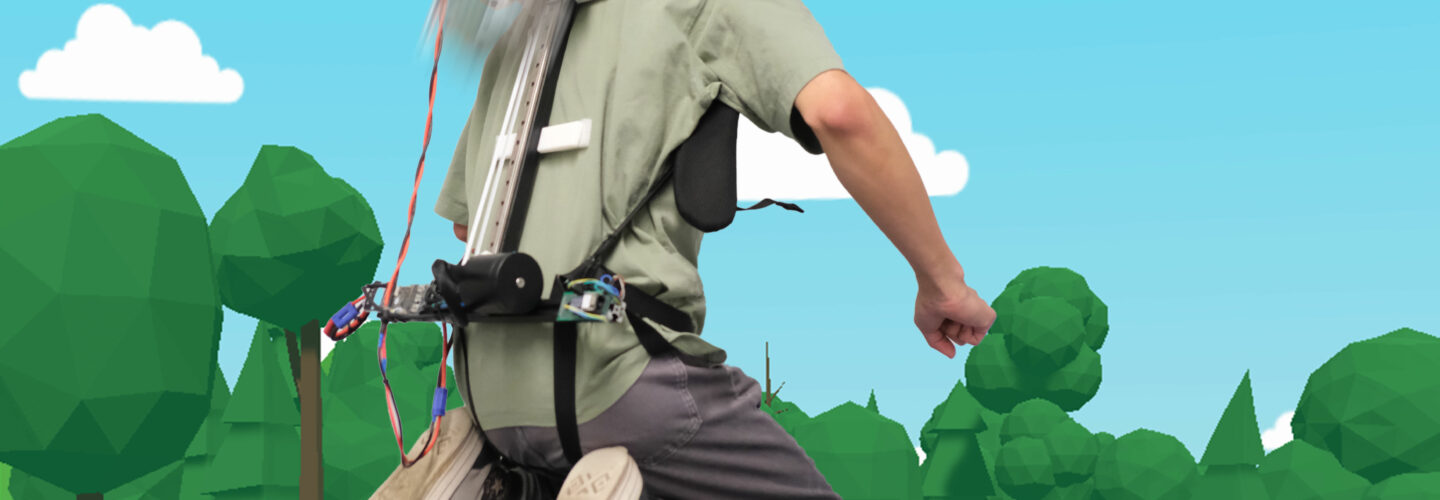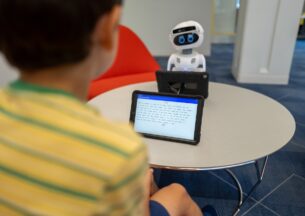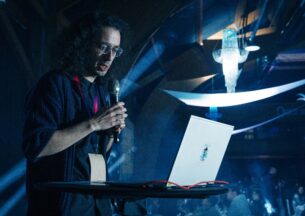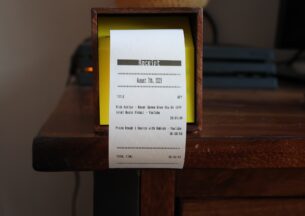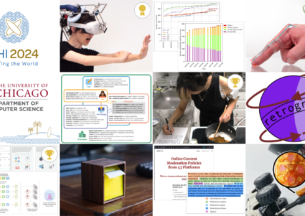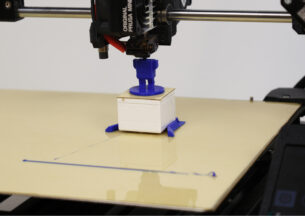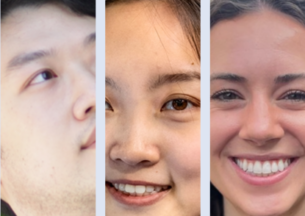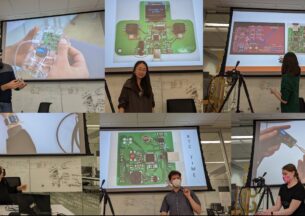UChicago Computer Scientists Design Small Backpack That Mimics Big Sensations
Immersive technology, like interactive sports or virtual reality, has leveraged the power of motion sensors to create a unique way for humans to interact with computers. While the technology does add a new layer of depth to a novel, at-home experience, it often falls short of realism for one critical reason: the sensors can’t provide a full-body sensation without large enough equipment capable of moving an entire human body. Recently, a group of scientists from the Human Computer Integration Lab at University of Chicago’s Department of Computer Science have been working on a solution to combat that problem.
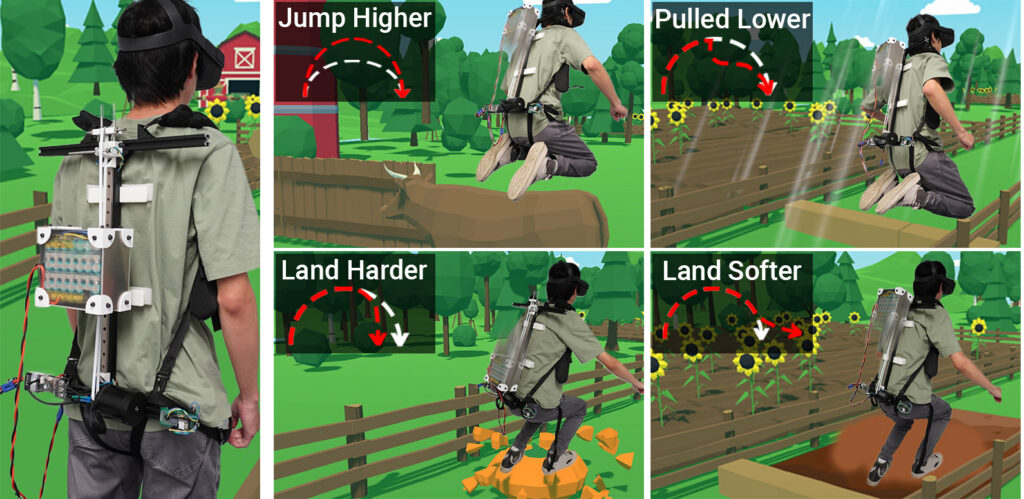 Alongside Associate Professor Pedro Lopes and a team of students, third-year Ph.D. student Romain Nith has designed a haptic device called JumpMod that uses vertical force-feedback to mimic the full-body feeling of gravity. The technology lives within a compact, wearable backpack and modifies the user’s perceived jump through five different effects: the feeling of jumping higher, landing harder or softer, and being pulled higher or lower.
Alongside Associate Professor Pedro Lopes and a team of students, third-year Ph.D. student Romain Nith has designed a haptic device called JumpMod that uses vertical force-feedback to mimic the full-body feeling of gravity. The technology lives within a compact, wearable backpack and modifies the user’s perceived jump through five different effects: the feeling of jumping higher, landing harder or softer, and being pulled higher or lower.
The team presented their work at the ACM CHI Conference on Human Factors in Computing Systems earlier this year but also took it on the road as a live demonstration to the ACM SIGGRAPH conference—a conference of around 15,000 attendees. While there, over 300 people had the opportunity to jump with the researcher’s device. The full paper details a breakdown of how JumpMod works, the hardware used, and the results from three different user studies.
The portable, untethered nature of JumpMod marks a distinct difference in comparison to other solutions. The backpack does not use any outside handles, platforms, or grounding technology, nor does it actually lift or move a person– which would allow access to hyper-realistic, immersive experiences at home a possibility in the not-so-distant future.
“If you want to modify the way you feel about gravity, then traditionally, you would need a motion platform, to go to a theme park and ride a roller coaster, or have an entire infrastructure with cables that can pull you up,” said Nith. “That all requires large machines and a lot of power as well. It’s obviously not practical to have those things inside your house if you are trying to experience similar sensations on a daily basis. So I’ve been investigating if there are ways we can shrink them down to a more manageable form.”
While it might seem like a simple problem to fix, gravity doesn’t necessarily work in favor of scalability.
“The reality is there hasn’t been an easy way to create these types of full body sensations because the physics don’t work,” explained Lopes. “We asked ourselves how it would be possible to generate the feeling of these large forces in a scalable device that could also still trick the human senses. JumpMod is one of the solutions we have landed on.”
In VR and other similar modalities, a lot of scientists have looked at the sensory experience on a horizontal field, leaving the vertical space much less explored. For example, creating the sensation of walking slowly by adding wind resistance can be an easy experience to recreate because you can simply add a fan to the space without having to do much else. However, recreating the feeling of gravity when moving up or down is a trickier process. When the team started experimenting with vertical space, they found that adding weight to the body in a controlled way was a great way to mimic the force of gravity.
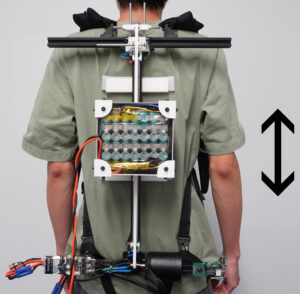 A small weight in the JumpMod backpack moves up and down the user’s back in combination with a motor to add acceleration. At specific moments in a virtual reality experience, the weight and motor is activated to create a pull or push on the body. If the user is trying to jump over something, the weight and motor moves toward the top of the backpack in tandem with the user’s movement. Once the user lands, the weight moves down at an accelerated speed to create the feeling of absorbing impact.
A small weight in the JumpMod backpack moves up and down the user’s back in combination with a motor to add acceleration. At specific moments in a virtual reality experience, the weight and motor is activated to create a pull or push on the body. If the user is trying to jump over something, the weight and motor moves toward the top of the backpack in tandem with the user’s movement. Once the user lands, the weight moves down at an accelerated speed to create the feeling of absorbing impact.
The team has tested JumpMod in the context of a virtual reality game, but the technology has the potential to be used in many other ways. Applied gravity could work to train athletes how to commit a movement to muscle memory, aid in physical therapy, help someone overcome a gravity-related fear such as falling or climbing, and a variety of applications that have yet to be explored.
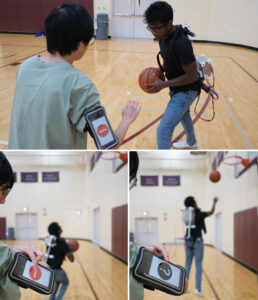 “I think one of the most interesting pieces of feedback we received when conducting demos was the potential application for someone working in CGI,” said Nith. “Actors can sometimes have a hard time getting into character or embodying a bigger avatar in front of a green screen because it’s largely imagination. For instance, if someone playing the Hulk wanted to strike down their arm, they might really enjoy this backpack because it could potentially create a stronger sense of punch.”
“I think one of the most interesting pieces of feedback we received when conducting demos was the potential application for someone working in CGI,” said Nith. “Actors can sometimes have a hard time getting into character or embodying a bigger avatar in front of a green screen because it’s largely imagination. For instance, if someone playing the Hulk wanted to strike down their arm, they might really enjoy this backpack because it could potentially create a stronger sense of punch.”
In the future, the team would like to continue exploring other avenues where this technology can be implemented.
“In the past decade we have seen tremendous advances in VR, with graphics and interaction bringing it to a point where it is easy to feel visually immersed,” Lopes added. “Yet, we think that unlocking the full potential of VR requires the physics to also “feel right”. With JumpMod, we took a step toward uncovering how a relatively small wearable device might alter a large sensation, such as one’s sense of weight during a jump. Now we want to look deeper into how to create more physical sensations while keeping the resulting prototypes small, so that they will be compatible with everyday life.”


